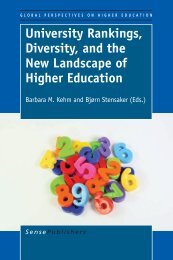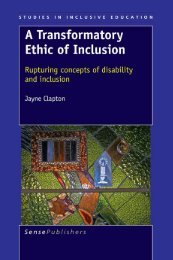Safe Spaces Human Rights Education in Diverse Contexts
Safe Spaces Human Rights Education in Diverse Contexts
Safe Spaces Human Rights Education in Diverse Contexts
Create successful ePaper yourself
Turn your PDF publications into a flip-book with our unique Google optimized e-Paper software.
A SOCIAL JUSTICE AND HUMAN RIGHTS EDUCATION PROJECT<br />
and social order.” He further argues that rituals as “forms of cognition are<br />
contrasted with practical knowledge” (ibid). These rituals <strong>in</strong>struct the community<br />
on the social and political order. In order to keep these power relations, cultural<br />
and religious, sacred rituals are ma<strong>in</strong>ta<strong>in</strong>ed from one generation to another.<br />
McAllister also expla<strong>in</strong>s (2009:281) that “(R)rituals are essential for ‘public<br />
reflexivity’ <strong>in</strong> the course of which groups are able to take stock of various aspects<br />
of their social situation.” Not all rituals and practices are part of the opaqueness of<br />
discrim<strong>in</strong>atory practices, therefore the ma<strong>in</strong> aim of the project was to identify<br />
whether religious and cultural practices are <strong>in</strong> conflict with human rights education<br />
and the empowerment of girls.<br />
As mentioned before power relations <strong>in</strong> society have a big <strong>in</strong>fluence on how<br />
research will be accepted and how research will impact on participants,<br />
especially <strong>in</strong> schools, either from African, Asian and/or Western perspectives. In<br />
South Africa, amongst most ethnic groups and religious and cultural<br />
communities, patriarchy still has a big <strong>in</strong>fluence on societal structures <strong>in</strong><br />
communities. Research (Ahmed et al., 2005) also <strong>in</strong>dicated that <strong>in</strong> spite of<br />
support for an establishment awareness of a society free of female genital<br />
mutilation (FGM) <strong>in</strong> the Sudan, the respondents from all walks of life (religious<br />
leaders from different groups to professional academics at universities) still<br />
<strong>in</strong>dicated that they still support FGM for their own daughters. These double<br />
standards (Ahmed et al., 2005:61–62) of, especially the academic professionals<br />
on FGM, is an alarm<strong>in</strong>g issue. It illustrates also the way of <strong>in</strong>fluenc<strong>in</strong>g and<br />
condon<strong>in</strong>g practices supported by the power relations of a patriarchal system.<br />
There are many examples <strong>in</strong> popular media on atrocities regard<strong>in</strong>g FGM <strong>in</strong> many<br />
parts of the develop<strong>in</strong>g world. In the domestic upbr<strong>in</strong>g<strong>in</strong>g of girls, the position of<br />
gender, their sexist roles and the particular set of values are associated with the<br />
social order <strong>in</strong> a community. It is also <strong>in</strong>terest<strong>in</strong>g to note that this “position<strong>in</strong>g” is<br />
strengthen especially by religious leaders.<br />
Sen argues that “positionality” and the theory of justice is “the specific role of<br />
public reason<strong>in</strong>g <strong>in</strong> the understand<strong>in</strong>g of gender roles and the demands for justice”<br />
(Sen, 2009:167). Nussbaum (2010:44) also emphasizes that “people behave badly<br />
when the human be<strong>in</strong>gs over whom they have power are dehumanized and de<strong>in</strong>dividualized”.<br />
When power relations are l<strong>in</strong>ked to positionality, gender<br />
disempowerment, the vulnerability of children and young girls (Satterthwaite,<br />
Watts & Piper, 2008:42) becomes part of the social construct of the community<br />
and society. Injustices become power obsessions and the moral basis of the<br />
tradition, <strong>in</strong> conflict with human reason<strong>in</strong>g.<br />
A society is governed by different social, cultural and religious pr<strong>in</strong>ciples and<br />
values. One should therefore be cautious <strong>in</strong> mak<strong>in</strong>g artificial dist<strong>in</strong>ctions between<br />
the private and the public doma<strong>in</strong> of society, especially <strong>in</strong> traditional communities.<br />
These different social spheres are embodied by different sets of values, and the<br />
diverse schools environments <strong>in</strong> the research represented these different sets of<br />
values. Sen (2009:170) stated that “(P)osition<strong>in</strong>g cannot be partly or wholly<br />
overcome <strong>in</strong> ways that take us to a less conf<strong>in</strong>ed view.” The role of an <strong>in</strong>dividual<br />
and their social position <strong>in</strong> the family and the community is important. The<br />
37














